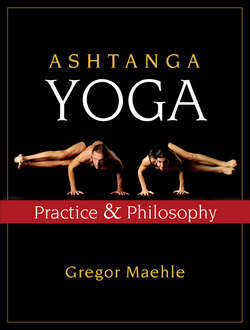Читать книгу Ashtanga Yoga - Gregor Maehle - Страница 223
На сайте Литреса книга снята с продажи.
Оглавление
Purvottanasana, vinyasa seven
The legs are straight and strong. Point the feet. Drop the coccyx toward the heels and dig the back of the heels down into the floor. This engages the hamstrings and the gluteus maximus. Lift the pelvis and uncoil the spine. Work the toes toward the floor until the soles of the feet cup the floor. Once up in the posture, the hamstrings can take over and you can release the buttocks; to go on contracting them would place a strain on the sacroiliac joints. Keep lifting the chest and continue to open it by positioning the shoulder blades broad and drawing them down the back, and by arching the upper back (erector spinae).
The head is the last to go back. Release the front of the throat and allow the head to hang back, relaxed. Gaze to the tip of the nose to keep the back of the neck elongated. This head position should not be adopted, however, if the student has neck problems or has suffered whiplash. The old pattern of a whiplash injury could be set off in the transitions in and out of this posture.
Instead, one can gently place the chin on the sternum and keep it there throughout the posture. Gaze toward the feet. The head should be lifted only when one has come back down to sitting. Done in this way, the neck muscles are not provoked into a spasm reflex. Hold Purvottanasana for five breaths.
